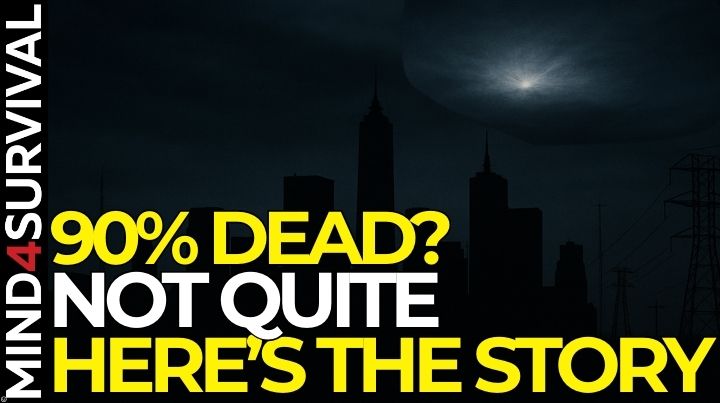Why the USA Attacking Iran Is a Losing Bet – Survivopedia

The alert came in while you were probably busy doing your thing, just like me, as I was taking inventory of my pantry. Just another hot morning. But then the push notification popped up like a cold slap: “US Launches Airstrikes on Iranian Nuclear Sites.”
Not a drill. Not a rumor. Real-world engagement. Bombs falling on Isfahan. Fordow flattened—allegedly. It wasn’t long before the word “war” started drifting into the headlines like smoke from a distant fire.
Now, if you’re the kind of person who reads maps the way others read horoscopes, you probably already knew this was brewing. And if you’re a prepper or even just someone with a basic sense of foresight, you also knew this wasn’t going to be a clean surgical strike that fixed anything. You don’t poke a hornet’s nest in the middle of a gasoline warehouse and call it pest control.
Let’s talk honestly about what just happened, what it means for regular folks trying to survive in an increasingly brittle world, and why this entire mess—however it spins—feels like a rigged gamble from the start.
The First Strike That Wasn’t The Last
The US called it “Operation Midnight Hammer”, and the name alone should give you pause. Hammer? Midnight? It’s as subtle as a bar fight. In the early hours of June 22nd, American B-2 stealth bombers and Tomahawk-equipped submarines coordinated a highly planned and—on the surface—well-executed attack on three of Iran’s nuclear facilities: Fordow, Natanz, and Isfahan.
Satellite data, open-source analysts, and even mainstream media confirmed significant hits on the facilities. Bunker-buster bombs—likely GBU-57 Massive Ordnance Penetrators—were used to hit underground enrichment halls. The goal? Knock Iran’s uranium enrichment program several years back. That’s the pitch we were sold, anyway.
But here’s the catch: Iran, like any nation that’s been sanctioned half to death and surrounded militarily, didn’t just sit on its hands. They’d hardened those sites. And while the US said the damage was “devastating,” Iranian and Russian state media called it “limited and symbolic.”
We’ll probably never know how deep the craters go until inspectors get in—or something leaks. There are already some photos being shared online showing that bombs have just made deep holes in the ground and nothing else. I cannot say if those are real or not. But what’s undeniable is the reaction that came next.
On June 23, Iran launched a wave of retaliatory missiles in an operation they called “Glad Tidings of Victory.” The primary target? Al Udeid Air Base in Qatar, the forward headquarters of CENTCOM and one of the most fortified American installations in the region. Here’s the thing, though: most of those missiles were intercepted. Qatar reported zero casualties. US CENTCOM said the same.
So, a brutal first punch. Then a return jab pulled just enough to show capability without escalation. Call it a warning, or a symbolic gesture, but either way, it didn’t end there. And it never does.
So Why Did the US Really Attack Iran?
You know the official story already—“degrading nuclear capabilities,” “preventing enrichment escalation,” “defending allies.” That’s the kind of language you hear from polished podiums and State Department spokespeople with dead eyes and perfect ties. But the real answer? Well, let’s say it’s a little messier than that.
The strikes came fast as a side effect of rising tensions between Israel and Hezbollah, particularly after Hezbollah launched multiple rocket barrages into northern Israel following Israeli operations in southern Lebanon. Iran, predictably, was framed as the puppet master. And sure, Iran’s hands are all over the region—that’s no secret. But here’s where things go sideways.
A large section of the American public isn’t buying the idea that the US just had to attack. Not now. Not without congressional approval. Not when domestic inflation is strangling people at the grocery store and housing is unaffordable in half the country.
And more than that, people are noticing a pattern. The conspiracy-leaning crowd, the libertarian right, the disillusioned left—all kinds of folks are starting to say the same thing: Donald Trump isn’t running US foreign policy—Netanyahu is.
On social media, it’s not just hashtags like #WWIII or #NoWarWithIran trending—it’s #TrumpIsNetanyahusPuppet. Harsh? Maybe. But when you look at the timing, the choreography, the eerily close alignment between Israeli provocations and American strikes, it gets harder to pretend we’re acting independently.
Critics argue that Trump, already embattled by legal issues and a chaotic election cycle, needed a foreign policy “win” that plays well with the pro-Israel base and neocon hawks. A neat little show of force. Something to remind voters that he’s “strong.” However, I ask you this: Is it strength if you’re doing someone else’s bidding, or is it obedience?
And if that’s true—if American blood and funds are being used to settle someone else’s regional grudges—then we’re not just looking at a bad bet. We’re looking at an entire casino rigged against us.
When wars are launched not from necessity but from political calculation, ordinary people pay the price. You, me, the guy filling propane tanks in Amarillo, the single mom budgeting for groceries in Philly—we all get hit.
So maybe the better question isn’t “Why did the US attack Iran?”
Maybe it’s: Who really pulled the trigger?
“We’re Not At War”—But Try Telling That to Your Grocery Bill
Let’s get one thing straight. You don’t need to be in a war zone to feel the heat of war. Ask any trucker navigating fuel prices this week. Ask a single mom watching meat double in price overnight. Ask the small-town grocer whose shipments from the Gulf are now “delayed indefinitely.”
The Strait of Hormuz—yeah, that tiny neck of water at the bottom of Iran—isn’t just some strategic trivia. It’s where 17 to 20% of the world’s oil floats through. Iran hinted at closing it, and just that whisper sent crude oil futures spiking past $105 a barrel. That’s not politics. That’s your wallet. That’s your generator fuel. That’s the propane tank for your stove and the diesel that keeps farm tractors rolling.
Some of us might remember the Gulf War price hikes. Or 2008’s recession punch combo. But this? It’s different. Because this one isn’t just about markets. It’s about fragility. Everything is connected by just-in-time shipping and digital inventory chains. Break the chain in the Persian Gulf and you’ll feel it at a gas station in Nebraska or a chicken farm in rural Bulgaria.
You can already see the early signs: thinner shelves at hardware stores, price hikes on anything with plastic components (thank you, petrochemicals), and food distributors tightening their outbound schedules. You don’t need a mushroom cloud to trigger a run on supplies—you just need a spike in diesel and a few nervous wholesalers watching the Strait.
And you know what hits harder than an Iranian missile? A clerk telling you: “Sorry, we’re out of stock.”
Iran Isn’t Iraq—and That’s Where This Gets Ugly
For those old enough to remember 2003, this might feel like déjà vu. But don’t be fooled. Iran isn’t Iraq. This isn’t a country with a shattered army held together by duct tape and fear. Iran is a regional powerhouse with layered air defenses, proxy networks across the Middle East, and domestic manufacturing capabilities hardened by two decades of sanctions.
The US strikes may have been precise, even surgical, but the strategic gain? That’s fuzzy. Iran’s response was calculated. No mass casualty retaliation. No swarm of missiles on Israel. Just enough to show capability, not enough to cross a line. That kind of restraint doesn’t come from weakness. It comes from knowing you hold some cards—maybe not all of them, but enough to mess up the table.
And let’s not forget the geopolitical balance. Russia’s watching. China’s watching. The Saudis are sweating bullets under their thawed relations with Tehran. Israel’s been posturing hard for months, possibly coordinating quietly. The Gulf States? Nervous and hedging.
This isn’t chess. It’s poker with gasoline-soaked cards and nobody’s folding.
The Ceasefire That Might Not Stick
On June 24, President Trump stepped out and declared a “complete and total ceasefire” between Iran and Israel. Sounds good on paper. Iran, reportedly, was to halt hostilities first. Israel would follow 12 hours later. But by morning, reports of rockets flying into northern Israel from “unconfirmed sources” had already surfaced.
So… was it a ceasefire or just a breather?
Iran’s foreign ministry played it carefully. “We did not agree to any formal terms,” they said, emphasizing that the calm was conditional, not contractual. That tells you all you need to know. Everyone’s cooling down, not because they want peace, but because no one can afford what comes next.
Which brings us back to the common man.
If you’re waiting to hear missiles before you start storing rice, you’re already late. Because while governments count missiles, regular people count bills. The ceasefire might hold for now. But if Israel strikes Hezbollah next week, or if a US drone hits a convoy in Syria, guess what? We’re right back in the mess. And every time we cycle through this, it gets harder to pretend the world isn’t cracking.
So, What Do We Do Now? (Yeah, This Is the Part You Came For)
You’re not reading this because you want doom and gloom. You’re reading it because you want clarity. You want answers, even if they’re uncomfortable. So, here’s the straight truth, from one realist to another.
If you’re a prepper, now’s the time to tighten your strategy. Not panic. Not go full tinfoil—but assess your weaknesses like you would after a wildfire came within five miles of your land.
Fuel’s about to get tighter. Stock accordingly, rotate aggressively, and don’t be the person hoarding jerry cans the day after the pumps run dry. Keep filters ready—clean water’s the first domino in any cascading crisis. Review your backup power setup. Solar’s great, but a cloudy week and no diesel? That’s a problem you want to solve before it happens.
Food-wise, shelf-stable calories should already be in your system. But here’s something most folks forget: food for barter. Trade cans, share supplies with the network you trust. Prepping isn’t just about solo survival—it’s about outlasting the chaos with a tribe.
Keep your comms simple but layered. If the Gulf flares again and undersea cables get hit (don’t laugh, it’s happened before), you might be relying on local HAM networks or even old-school CB.
And mentally? Stay ready. Not paranoid. Just ready. There’s a difference.
Closing Thoughts—Why the Empire Never Learns
I’m an honest man and I don’t like to beat around the bush. This isn’t about Iran. Not really. This is about a failing empire needing a win, any win, to distract from the rot at home. When the debt ceiling’s a joke, when inflation’s hammering working families, when civil unrest is brewing—there’s always a foreign villain to point fingers at.
But Iran didn’t attack Kansas. It didn’t send boots into Florida. It got hit. Hard. And it hit back just soft enough to avoid nuclear hellfire. That’s not aggression. That’s restraint.
So, what happens next? Maybe this moment cools off. Maybe oil flows again. Maybe prices stabilize. Maybe we all forget about this by Christmas.
But maybe it doesn’t. Maybe someone flinches. Maybe an Israeli jet hits a convoy in Syria. Maybe a Hezbollah cell in Lebanon launches something big. Or maybe a US sub gets too close to the wrong island in the Gulf.
And then we’re in it.
That’s why we prep. Not because we want collapse. But because we’ve seen enough to know it doesn’t always come with a warning siren. Sometimes it comes with a CNN banner and a White House press release.
This was a losing bet. A short-sighted strike that might earn headlines but costs stability. And we’re the ones paying the tab.







